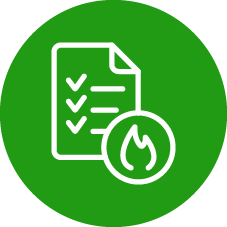Safe Systems of Work
Easy as 1-2-3
A large percentage of accidents occur each year due to a lack of, or failure, in systems of work.
Implementing safe systems of work (SSOW) is an important part in managing risks associated with work activities.
After all, working without a sensible set method for carrying out a task safely is intrinsically risky.
SSOWs need to be continually reviewed and communicated to your employees. They need to know what they are doing and how to do it safely.
What is an SSOW and why does my business need one?
Safe systems of work (SSOW) are structured processes designed by health and safety experts to reduce the risk of harm when employees face unavoidable hazards at work.
SSOWs are an extremely powerful way to protect your staff from unnecessary risks to their health. Employers have both a legal and moral duty to create safe systems of work whenever staff face significant risks in the workplace.
Health and safety legislation requires employers to create systems of work that, as far as is ‘reasonably practicable’, allows employees to work in an environment that does not create unnecessary risks to their health. Although it may not be possible to eliminate all risks, safe systems of work are an important tool for mitigating them.
Safe systems of work start life with a risk assessment analysing all aspects of a business to highlight potential hazards.
If a risk assessment highlights tasks that present significant hazards that can not be avoided, businesses work with health and safety experts like us to design tailored SSOWs that reduce the risk of staff suffering from illness, injury, or death. SSOWs formalise step-by-step guidance to help employees complete tasks in a way that reduces the risks to their health.
The language of an SSOW needs to be universally understandable, clear and direct. Its purpose is to give employees specific instructions on how to work safely and should not be mistaken for general guidance. Tasks and activities are broken down into successive steps that employees need to complete in order.
Over the years, thousands of businesses from a wide range of industries have trusted The H&S Dept to design and implement safe systems of work.
Our experts would be more than happy to support your business from the risk assessment phase right the way through to implementing bespoke SSOWs for your business.
What does The Health & Safety Dept SSOW include?
Our health and safety experts take the time to learn about your business, the activity, and the people that may be harmed, so that our SSOWs are robust, and give you peace of mind that your staff can work safely.
What does a good SSOW look like?
A good SSOW should:
- Be designed for a specific task or activity
- Identify all hazards related to the task or activity
- Detail each individual step for safely completing the task or activity
- Be easily accessible for everyone who needs it
The first step in designing an SSOW is to hire health and safety experts to complete a full risk assessment for the task or activity. This initial assessment will identify hazards and highlight which hazards require safe systems of work to keep your staff safe.
To avoid missing any hazards during the risk assessment, the health and safety professional completing the assessment would benefit from engaging with staff who are involved with the task or activity. A good SSOW is designed in close collaboration with the employees who do the tasks because they are best placed to explain how they work and the risks they face.
For example, a risk assessment might highlight that employees in a warehouse need to frequently lift very heavy boxes as part of their role. As a result, employees risk developing long-term health problems unless they are helped to complete the tasks safely. This is where a health and safety professional can observe and analyse what they need to do to create a tailored SSOW that helps make sure everyone does it safely.
It is important to consider that designing an SSOW is not enough on its own. Regardless of how brilliant an SSOW may be, it is useless unless everyone it impacts knows it exists and can apply it in their roles.
Employees need to be aware of SSOWs before performing tasks that fall under their scope. Safe Systems of Work can be made more accessible by writing them in clear language and including annotated images, diagrams, and anything else that helps make them as clear as possible.
Our external expert perspective will help to ensure that your business is doing all it can to keep your employees safe.
Safe Systems of Work FAQ
What is an SSOW?
SSOWs offer structured processes for how employees can safely complete specific tasks that present significant and unavoidable risks. Safe systems of work are step-by-step processes designed in collaboration with health and safety experts to help employees safely complete these tasks in a way that minimises the risk of injury, illness, or death.
Who is responsible for carrying out an SSOW?
Employers are responsible for sourcing competent health and safety support when designing safe systems of work for tasks and activities that present significant risks to the health of their staff.
Are businesses legally required to have an SSOW?
Under Section 2(a) of the Health and Safety at Work etc Act (HSWA) 1974, employers must, ‘so far as is reasonably practicable’, provide and maintain systems of work that are practical, safe and without risks to health.
What are the 5 key steps for developing an SSOW?
- Complete a full risk assessment for the task or activity
- Identify and examine hazards that present significant risks.
- Establish methods that reduce the level of risk for these tasks or activities.
- Document a step-by-step process and train staff on how to apply it.
- Monitor how the SSOW performs and reassess it regularly.
How often does an SSOW need to be reviewed?
Safe Systems of Work should remain dynamic and be continually reviewed throughout the task or activity. The employer must make regular updates or amends when information or a situation is presented that afford the SSOW an improvement.
Safe systems of work need to be frequently reviewed to make sure that they are still appropriate for the tasks they were designed for.
It is important to immediately reassess an SSOW when there are changes that impact a task. Examples of this could include the introduction of new machinery or changes in levels of staffing.
What documentation is needed to support an SSOW?
A formal risk assessment to identify risks must be completed in advance of designing a SSOW. Employers are required to train staff who complete tasks covered by an SSOW and give them the opportunity to seek clarification. This is key because dumping a load of important information on staff without letting them ask questions risks them not understanding what they need to do (this is called the human error). Businesses must keep evidence of training for each employee in their HR records.
What is the difference between an SSOW and a method statement?
An SSOW goes into more detail than a method statement. In addition to detailing steps for safely completing tasks, an SSOW includes additional information such as what to do if there is an emergency and a formal process for monitoring and updating the SSOW. Not everybody needs this level of detail, so method statements are often created as trimmed versions that offer role-specific information.
Need help making sure your systems are safe?
Related content

Related Services

Fire Risk Assessments

Risk Assessments

Accident Investigations

Looking for expert health & Safety support?
We can help you focus on your business by taking care of all your health & safety needs.
Let us know how we can help or ask about our free initial H&S review.
Safety solutions that grow with you
Get in Touch
Subscribe to our newsletter
Office Address: The Health & Safety Dept, First Floor, 3 Brook Office Park, Emersons Green, Bristol, BS16 7FL | VAT Number: 900674738 | Registration Number: 06316590
Copyright © 2007 – 2023 The H&S Dept Ltd. H&S DEPT is a registered trademark belonging to The H&S Dept Limited.




